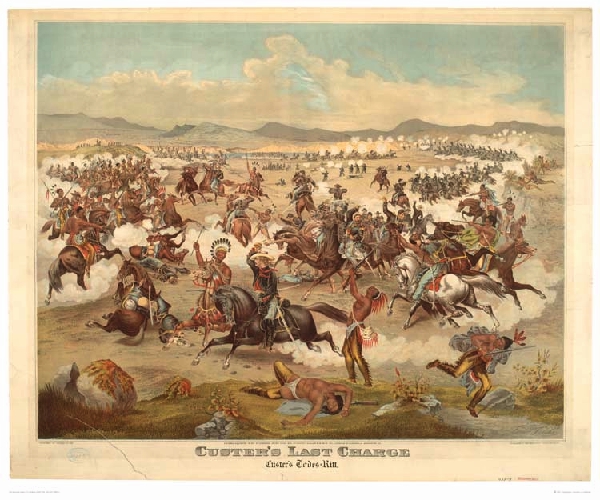
Custer's Last Charge,
Lithograph by [Theodore?] Fuchs, undated
Some question exists as to attribution for the
above lithograph. The first name of the artist has been shown by authories as
both "Theodore," and "Feadore." The only well known illustrator by the name of
Fuchs of the period, however, was
Emil Fuchs (1866-1929) who studied at the Imperial Academy in Vienna and the
Royal Academy, London, before immigrating to the United States in 1905.
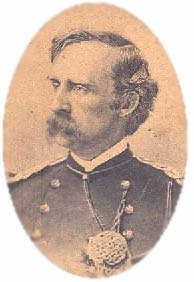 Lt. Col. (Brevet Maj. Gen.) George Armstrong Custer.
Lt. Col. (Brevet Maj. Gen.) George Armstrong Custer.
Writers
have put partial blame for Custer's defeat on Crook for not having warned
of the large Indian forces at the Rosebud. See
Fort Fetterman. However, when Terry, Gibbon, and Custer met on June 21, they
had not recieved word of Crook's retreat back to Goose Creek from Rosebud. The failure to
receive such intelligence lay with Custer. As will be observed below,
Gen. Terry instructed Custer to send a scout to Crook. He failed to do so.
Nevertheless, assuredly, Custer was aware of the numbers of Indians. His scouts had
warned him that there were enough Indians to fight many days. A Crow scout, Half-Yellow-Face,
warned Custer, "You and I are both going home today by a road we do not know." Custer with his own eyes using
a spy glass he observed the largest congregation of Indians ever assembled on
the American plains. The plan was for Gibbon, Terry, and Custer's forces to meet on the
26th. As Custer set forth, Terry warned, "Now, Custer, don't be greedy, but wait for us."
Instead, Custer placed emphasis on Terry's official order, writing Mrs. Custer on the 22nd:
I send you an extract from General Terry's official order, knowing how keenly you apprciate words of
commendation and confidence, such as the following: "It is of course impossible to
give you any definite instructions in regard to this movement; and were it
not impossible to do so, the Department Commander places too much
confidence in your zeal, energy, and ability to wish to impose upon you
precise orders, which might hamper your action when nearly in contact with the
enemy."
Custer's extract was, perhaps, taken out of context and did not afford Custer a blank check.
The full text of the order:
Headquarters of the Department of Dakota (In the Field)
Camp at Mouth of Rosebud River, Montana Territory June 22nd, 1876
Lieutenant-Colonel Custer,
7th Calvary
Colonel: The Brigadier-General Commanding directs that, as soon as your
regiment can be made ready for the march, you will proceed up the Rosebud
in pursuit of the Indians whose trail was discovered by Major Reno a few
days since. It is, impossible to give you any definite instructions in
regard to this movement, and were it not impossible to do so the Department
Commander places too much confidence in your zeal, energy, and ability to
wish to impose upon you precise orders which might hamper your action when
nearly in contact with the enemy. He will, however, indicate to you his own
views of what your action should be, and he desires that you should conform
to them unless you shall see sufficient reason for departing from them. He
thinks that you should proceed up the Rosebud until you ascertain
definitely the direction in which the trail above spoken of leads. Should
it be found (as it appears almost certain that it will be found) to turn
towards the Little Bighorn, he thinks that you should still proceed
southward, perhaps as far as the headwaters of the Tongue, and then turn
toward the Little Horn, feeling constantly, however, to your left, so as
to preclude the escape of the Indians passing around your left flank.
The column of Colonel Gibbon is now in motion for the mouth of the
Big Horn. As soon as it reaches that point will cross the Yellowstone
and move up at least as far as the forks of the Big and Little Horns. Of
course its future movements must be controlled by circumstances as they
arise, but it is hoped that the Indians, if upon the Little Horn, may be
so nearly inclosed by the two columns that their escape will be impossible.
The Department Commander desires that on your way up the Rosebud you
should thoroughly examine the upper part of Tullock's Creek, and that you
should endeavor to send a scout through to Colonel Gibbon's command.
The supply-steamer will be pushed up the Big Horn as far as the forks
of the river is found to be navigable for that distance, and the Department
Commander, who will accompany the column of Colonel Gibbon, desires you to
report to him there not later than the expiration of the time for which
your troops are rationed, unless in the mean time you receive further
orders.
Very respectfully, Your obedient servant,
E. W. Smith, Captain, 18th Infantry A. A. J. G.
Custer's letter did little to assuage Libby Custer's fears. When Custer's forces departed
from Ft. Abraham Lincoln, Mrs. Custer rode with her husband a distance. In her
1885 "Boots and Saddles" or Life in Dakota with General Custer, she
described the line of troops, horses and wagons marching
off as the band played The Girl I Left Behind Me. A mirage formed in which the procession appeared in air halfway
between Heaven and Earth until it disappeared into the morning mists.
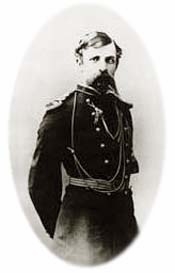 Edward S. Godfrey
Edward S. Godfrey
On the 22nd, a change of attitude on the part of Custer became apparent to some of his
officers. Edward Godfrey later wrote that Custer explained to his officers
his rationale for refusing Terry's offer of extra units from the Second
Cavalry and Gatling guns. Godfrey continued:
This "talk" of his, as we called it, was considered at the time as
somethng extraordinary for General Custer, for it was not his habit to
unbosom himself to his officers. In it he showed a lack of self-confidence,
a reliance on somebody else; there was an indefinable something that was not
Custer. He manner and tone, usually brusque and aggressive, or somewhat
rasping, was on this occasion conciliating and subdued. There was something akin to an
appeal, as if depressed, that made a deep impression on all present. We
compared watches to get the official time, and separated to attend to our
various duties, Lieutenants McIntosh, Wallace, and myself walked to our bivouac for
some distance in silance, when Wallace remarked: "Godfrey, I believe Custer is
going to be killed."
Wallace survived the seige on Reno's Hill, but was
later killed at Wounded Knee.
On the 24th, Custer's units camped at the site of an earlier Indian encampment. It was
Custer's habit to have his personal standard placed outside his tent. Godfrey
wrote that following an officers' call:
[A] stiff southerly breeze was blowing; as we were about to
separate, the General's headquarters flag was blown down, falling toward our rear. Being
near the flag, I picked it up and stuck the staff in the ground, but it fell again to
the rear. I then bored the staff into the ground where it would have the
support of a sage-bush.
Godfrey recalled that another nearby officer later remarked that he regarded the standard falling
to the rear as a bad omen, and felt sure the unit would suffer a defeat.
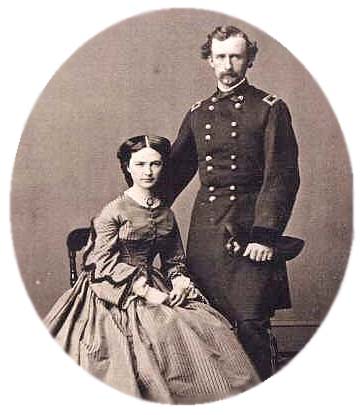 George A. Custer and Elizabeth B. Custer
George A. Custer and Elizabeth B. Custer On June 25, while unbeknowst to them the
battle was ensuing, wives of many of the officers gathered in the Custer quarters. Mrs.
Custer later wrote:
On Sunday afternoon, the 25th of June, our little group of saddened women,
borne down with one common weight of anxiety, sought solace in gathering
together in our house. We tried to find some slight surcease from trouble
in the old hymns: some of them dated back to our childhood's days, when our
mothers rocked us to sleep to their soothing strains. I remember the grief
with which one fair young wife threw herself on the carpet and pillowed her
head in the lap of a tender friend. Another sat dejected at the piano, and
struck soft chords that melted into the notes of the voices. All were
absorbed in the same thoughts, and their eyes were filled with far-away
visions and longings. Indescribable yearning for the absent, and untold
terror for their safety, engrossed each heart. The words of the hymn,
"E'en though a cross it be,
Nearer, my God, to Thee,"
came forth with almost a sob from every throat.
At that very hour the fears that our tortured minds had portrayed in
imagination were realities, and the souls of those we thought upon were
ascending to meet their Maker.
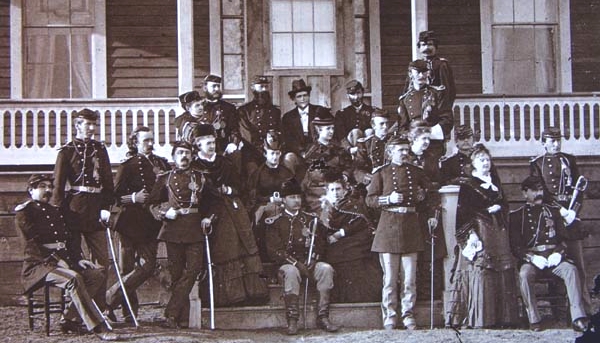
Officers and wives at Ft. Lincoln, 1873.
Custer standing, without hat, Mrs. Custer standing on bottom step on left.
Photo by Orlando Scott Goff.
Orlando Scott Goff (1843-1916) in the 1860's maintained a photography studio in
Yankton, Dakota Territory. In the early 1870's he was the post
photographer at Fort Abraham Lincoln. Later he worked as a traveling
photographer across Dakota, Montana, and Idaho Territories.
Mrs. Custer's premonotion was not the only one. Sitting Bull had a dream in which
he observed soldiers falling upside-down fron the sky. He took it as a favorable
omen.
And on the same afternoon as the wives were singing Nearer, My God, To Thee, General
George Crook and his officers, having retreated from the Rosebud, were enjoying an
afternoon of hunting in the foothills of the Bighorns near present day Sheridan. One of
their scouts, Frank Grouard known to the Brulé as "One-Who-Catches" and to the Lakota as
"Standing Bear, acted as guide. There, in the distance, he later wrote, Grouard
saw the smoke from signal fires indicating that Custer's command was then
engaged, outnumbered, and being badly pressed. The officers using their
field glasses made no import from the smoke and laughed at the idea that
a half-Indian could have such knowledge. But Grouard was not the only one who sensed something was amiss.
Gen. Crook's mess cook, George H. Boswell, in 1924 related to Thomas Julian
Bryant that on the afternoon of June 25, the sound of gunfire could be distinctly heard in the distance. See Annals of
Wyoming, 3:3 at pp 184-185.
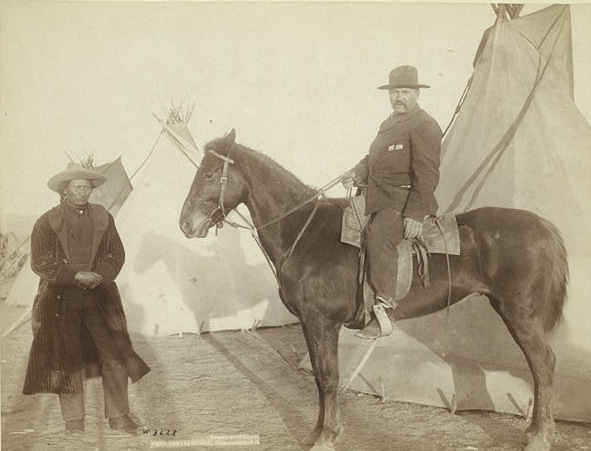
Rocky Bear and Frank Grouard, 1891, photo by
John C. H. Grabill
[Writer's note: Grouard at age 19 was captured by Sioux and spent the next 6 or
7 years in the camps of Sitting Bull and Crazy Horse. He was adopted as a
brother by Sitting Bull. Grouard was instrumental
in the surrender of Crazy Horse and has been blamed by some as being instrumental
in the subsequent death of Crazy Horse. Some question exists as to Grouard's
ancestry. Many writers claim that he was African-American, the son of the early Black
American Fur Company mountainman John Brazeau. By 1833, Brazeau operated
a trading post on the Yellowstone known as "Braseau's Houses" and married a
Sioux. Grouard, himself, claimed to be partial
Hawaiian, a claim which at the time was greated with considerable skepticism. Truth, however,
can sometimes be stranger than fiction. In 1846, Benjamin P. Grouard went on Mission to the
Tuamotu Islands, today a part of French Oceana and remembered as the landing site for
Thor Heyerdahl's Kon Tiki. After several years, the elder Grouard returned to
California bringing with him a Polynesian wife and three children. Interestingly, 30 years later
more missionaries arrived in the Tuamotu Islands and discovered that some of the natives still remembered
Grouard and his teachings relating to the Prophet Joseph. After a year in
California, Grouard's wife returned to the South Pacific with two of the children, leaving
Benjamin with the middle child Frank. Benjamin then turned the child over to
fellow Mormon missionaries, Addison Pratt and Louisa Pratt, for care. Grouard was excommunicated
from the Church as a result of doctrinal differences. The Pratt's emigrated to
Utah, taking with them the young Grouard. Grouard ran away. The elder Grouard ultimately remarried and
started another family. He, however, despaired of ever seeing Frank again. In
1893, Frank Grouard had become famous, and the elder Grouard read of the publication
of a biography of the scout. Benjamin then travelled to Sheridan where Benjamin immediately
recognized his son, notwithstanding a forty-year separation.
Grouard had little use for Col. Cody who had business interests in Sheridan. One time, the
two almost came to blows in the Sheridan Inn when Col. Cody was repeating his story of having killed
Yellow Hand. Grouard told Cody, "You are nothing but a picture book scout and a picture book showman. That's all you
ever were and that's all you ever will be." Frackelton, p. 109.]
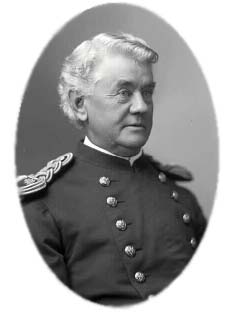 Frederick W. Benteen
Frederick W. Benteen
On the 22nd, Custer and Terry's forces separated. On the 23rd, the troops covered
35 miles. On the same day Crook and his men were near present day Big Horn City, south of present day
Sheridan. On the 24th, Custer covered 45 miles, and after dark another 10.
With the pace, the troops and the horses were exhausted. It was not unusual for
Custer to engage in brutal forced marches. Indeed, he was referred to by some of his men as
"Iron Butt." On the morning of the 25th, the coffee made from bad water was undrinkable. Indeed, the
water was so bad the horses would not drink.
About noon, Captain Frederick W. Benteen was instructed by Custer to
scout out to the southwest along the the foot of Wolf Mountain. Benteen later testified that
this order was senseless since the main Indian trail led off in another direction. About 2:00
p.m. a small force of Indians was spotted and Major Marcus A. Reno was instructed to give chase. As to
this order Benteen testified that Custer did not make clear to Reno the purpose of the order.
Thus, Custer's forces were divided into three. As Reno gave pursuit, Custer moved on. Allegedly, the
last sight of Custer was on a distant ridge waving.
Music this Page:
The Girl I left Behind Me
The hours sad I left a maid
A lingering farewell taking
Whose sighs and tears my steps delayed.
I thought her heart was breaking.
In hurried words her name I blest.
I breathed the vows that bind me;
And to my heart in anguish pressed
The girl I left behind me
Then to the east we bore away
To win a name in story.
And there where dawns the sun of day,
There dawned our sun of glory,
The place in my sight,
When in the host assigned me,
I shared the glory of that fight,
Sweet girl I left behind me
Though many a name our banner bore
Of former deeds of daring,
But they were of the day of yore
In which we had no sharing.
But now our laurels freshly won
With the old one shall entwine me,
Singing worthy of our size each son,
Sweet girl I left behind me
The hope of final victory
Within my bosom burning
Is mingling with sweet thoughts of thee
And of my fond returning.
But should I n'eer return again,
Still with thy love I'll bind me.
Dishonour's breath shall never stain
The name I leave behind me.
Next page: Reno and Benteen's Fight.
|